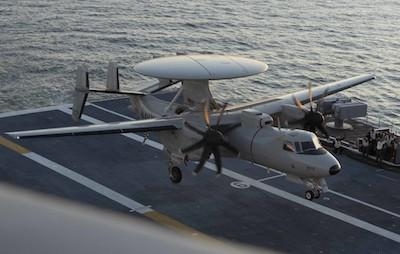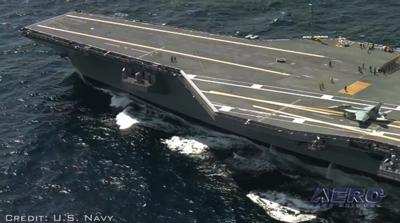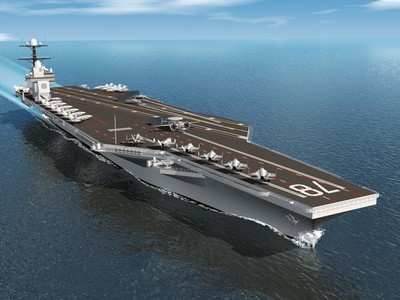USS Ford Concluded Its First-Ever Fleet Replacement Squadron (FRS) Carrier Qualifications (CQ)
The aircraft carrier USS Gerald R. Ford (CVN 78) concluded its first-ever Fleet Replacement Squadron (FRS) carrier qualifications (CQ) for Naval aviators while underway in the Atlantic Ocean, April 4.

The mission of the FRS is to train pilots, naval flight officers and maintainers on the specific front-line aircraft they have been assigned to fly. Some pilots may be training for current and upcoming deployments, where they will relieve currently-deployed pilots serving in fleet squadrons. Ford is currently the only carrier operating on the East Coast available to qualify pilots.
The CQ included both day and night flight operations, and required the ship and her crew of more than 2,600 Sailors to work in unison with Strike Fighter Squadron (VFA) 106 and Carrier Airborne Early Warning Squadron (VAW) 120 around the clock to help the squadron pilots successfully complete the final stages of their training.
“Our integration with the Ford team has been seamless; it’s been fantastic,” said Cmdr. Dan Catlin, commanding officer of VFA-106. “There were a lot of unknowns coming into this, because this is the first time that Ford has done a CQ, but this is a phenomenal crew of people. They’re performing as if they just came back off a full deployment.”
During carrier qualifications, an FRS pilot must develop and hone the demanding skills needed to take off and land fixed-wing aircraft on an aircraft carrier, performing many tests for the first time, including landing on a ship at night, relying on the systems and personnel on the ship to safely guide them to the flight deck.

“For the first time ever this ship conducted carrier qualifications for two fleet replacement squadrons and generated readiness for the fleet,” said Capt. J. J. Cummings, Ford’s commanding officer. “Our crew has trained hard for two years to prepare for this underway, and it was inspiring to watch their motivation, enthusiasm and straight stick professionalism. The crew knows that many of these aviators will be headed right out to deployed squadrons and that makes them extremely proud.”
In order for FRS pilots to qualify and advance into a fleet squadron, the pilot must successfully complete two “touch and go’s” with 10 day landings and two ‘touch and go’s” with six night landings aboard an aircraft carrier. On Ford, they found a crew that was eager to assist them in achieving that most critical set of steps.
“I’ve been on the flight deck of a lot of aircraft carriers in my career, and I’ve never seen a crew better than this crew on the Ford,” said Lt. Cmdr. Matt Deppen, from Skokie, Illinois, the head Landing Signal Officer on the East Coast, assigned to Commander, Naval Air Force Atlantic.
Deppen is responsible for the qualification of every Category 1 pilot (newly winged aviators transitioning from one type aircraft to another) from VFA-106 and VAW-120, and has flown on 10 different aircraft carriers.

“[The Ford crew] has blown me away, from the actual air department, to the crew up in the tower down to the actual flight deck itself, everyone has been unbelievably phenomenal. It shows that they’ve put in a lot of hard work and they’ve been training very hard, and they’ve all done an unbelievable job during this underway.”
Fourteen pilots qualified from VFA-106 and another 13 qualified from VAW-120 during the CQ period. The squadrons registered a combined 425 catapults (launches) and 495 traps (arrested landings) during their time aboard Ford.
Gerald R. Ford is a first-in-class aircraft carrier and the first new aircraft carrier designed in more than 40 years. Ford is underway conducting an independent steaming event in the Atlantic Ocean.
ANN salutes Mass Communication Specialist 1st Class Jeff Troutman, USS Gerald R. Ford Public Affairs.



 ANN's Daily Aero-Term (05.02.24): Touchdown Zone Lighting
ANN's Daily Aero-Term (05.02.24): Touchdown Zone Lighting Aero-News: Quote of the Day (05.02.24)
Aero-News: Quote of the Day (05.02.24) Aero-News: Quote of the Day (05.03.24)
Aero-News: Quote of the Day (05.03.24) ANN's Daily Aero-Term (05.03.24): UAS Traffic Management (UTM)
ANN's Daily Aero-Term (05.03.24): UAS Traffic Management (UTM) ANN's Daily Aero-Linx (05.03.24)
ANN's Daily Aero-Linx (05.03.24)








